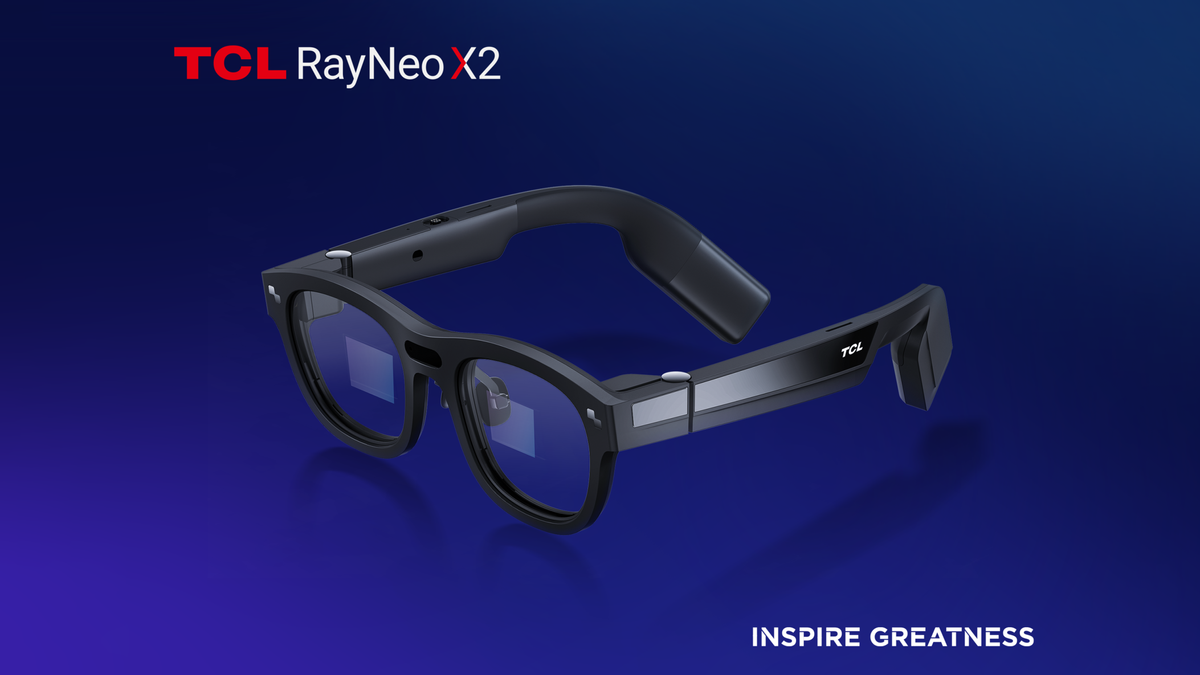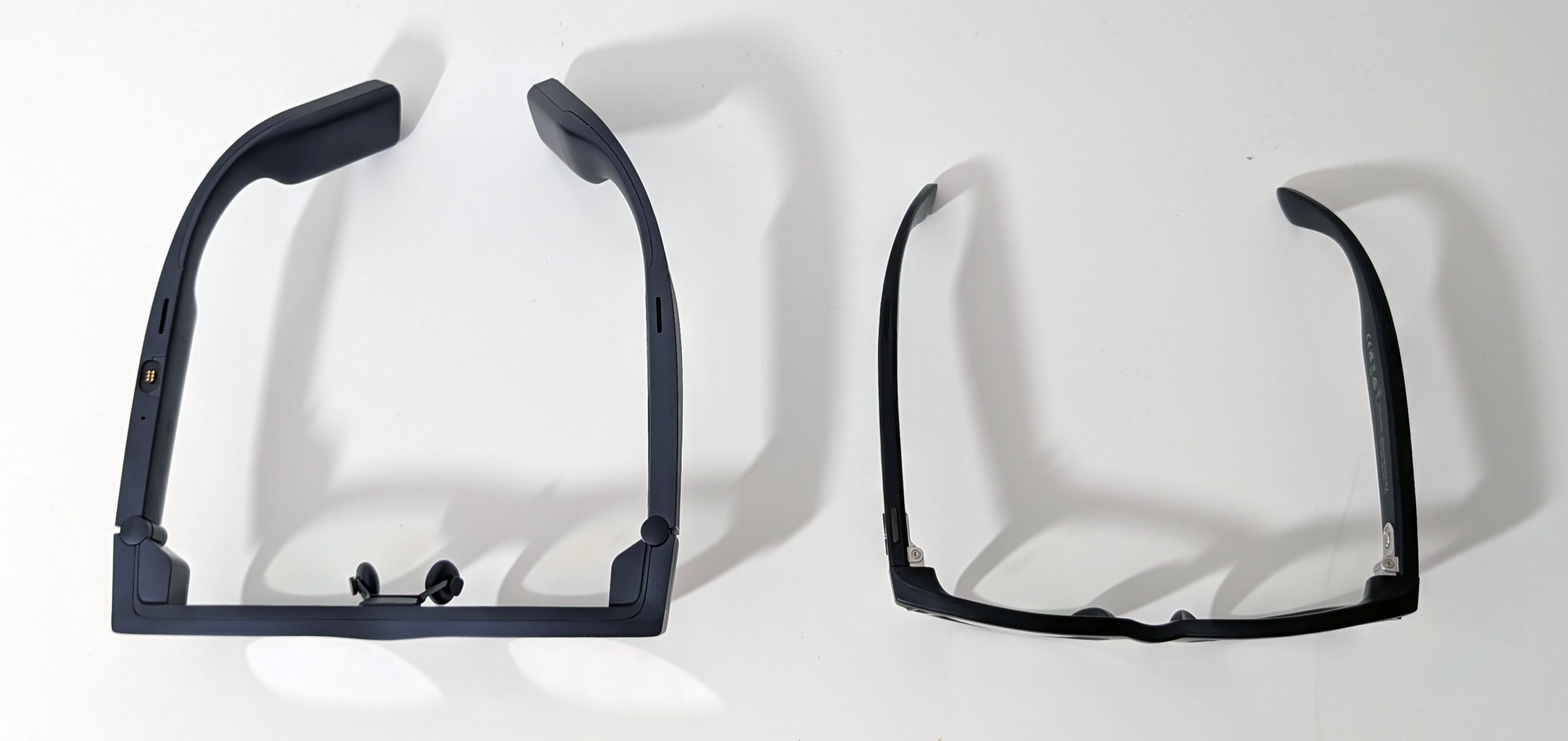But is it any good? The X2 began shipping in May to Indiegogo supporters, with a price of $850. The device technically achieves two firsts: not only is it the first standalone AR glasses, meaning it doesn’t require a separate compute device or battery, but it’s also the first AR device with full-color microLED displays.
RayNeo X2 has a full Snapdragon XR2 chipset on board, the same used in Meta Quest 2, and the company claims the glasses are capable of the kind of out-of-home use cases people have been envisioning for AR glasses for years now, including outdoor navigation and realtime speech translation anchored to the person speaking. Are any of these claims true?
Design & Comfort
TCL Crowdfunding RayNeo X2, The First Standalone AR Glasses
TCL launched the crowdfunding campaign for RayNeo X2, the first standalone AR glasses and the first with microLED displays.

RayNeo X2 is in true glasses form factor. Unlike birdbath optics glasses such as Xreal and its clones, they don’t sit out from your face.
That said, they are noticeably larger and bulkier than regular glasses and Ray-Ban Meta smart glasses, pushing to the very limits of outdoor social acceptability and perhaps, for many people, just beyond.
They’re also heavier. Ray-Ban Meta smart glasses weigh 50 grams. RayNeo X2 weights 120 grams. The thick padding on the stems and nose pads act as counterweights. The arms are also made of a softer feeling plastic than Ray-Ban Meta glasses.

Overall, I actually find them just as comfortable, though I do notice the weight more. This is not a fair comparison. The Ray-Ban Meta glasses require your phone for much of their functionality and lack any kind of display, while RayNeo X2 is fully standalone, bar the need for your phone’s Wi-Fi.

MicroLED + Waveguide Optics

What enables RayNeo X2 to achieve its true glasses form factor is the use of waveguides, the same optical approach

and
will likely use in their AR devices, as well as the use of microLED for its displays – a first in a consumer product anywhere near this price range.
MicroLED displays are very efficient and very bright, allowing RayNeo X2 to output 1000 nits despite its tiny battery, around 10 times as bright as headsets like Quest 3 and Apple Vision Pro, and twice as bright as micro-OLED birdbath glasses like Xreal. In practice, this meant I could still see RayNeo X2’s displays outdoors on a sunny day.MetaBut the microLED and waveguides optical stack also comes with notable downsides.SnapFirstly, the field of view is tiny, just 26 degrees. This cripples X2’s viability as an AR device, as I’ll expand on later, but it’s perfectly reasonable for a HUD (heads-up display).
Another downside on paper is that being the first microLED displays, they are very low resolution, at 640×480 per eye. The low field-of-view means that the angular quality is comparable to the Meta Quest 3 headgear, which is sufficient for the many uses of RayNeo. Transparent AR optics, in theory, offer a clear view of reality, without the graininess and distortion that passthrough mixed-reality headsets cause. This appears as an elongated streak of colors when you look at your monitor or phone. The form, comfort, optics, and display of RayNeo X2 have been described. But what can you actually do with it, and how well do these features work?
Non-Display Features
RayNeo X2 has a camera and speakers, so technically it can do everything Ray-Ban Meta glasses can. You can use it to take photos and videos or listen to music, podcasts, or audiobooks, and it has its own AI assistant.
The speaker quality is pretty much the same as Ray-Ban Meta glasses, and has the same advantage that you hear the real world undistorted since nothing is touching or covering your ears. The speaker quality is good for audiobooks and podcasts, but not ideal for music. The camera is landscape so it’s not great for posting on social media. It also can’t always see the objects that you are holding. This defeats the whole purpose of first-person video capture. It’s also grainier than the camera on Ray-Ban Meta glasses and has worse exposure control, but also seems to have higher bitrate.
RayNeo also has its own AI assistant. There’s also no way to activate it by saying “Hey Meta”. You have to go to its app in the menu to start it. However, other apps are not allowed to be used during this time. The RayNeo X2 is a lot more clunky and frictional than Meta’s solution. It uses the screen to display both the voice output and that of the character as text and audio. RayNeo X2 has features which are only possible with a display. Ray-Ban Meta Glasses do not have this feature. Meta AI will tell you when you get a message, but RayNeo can display it in a popup. Choose which apps to display and you will hear a beep. The preview is displayed in the pop-up. The HUD is similar to the smartwatch but you don’t have to look at it. It would be nice if the HUD was not in your direct line of sight. Ideally, some day with future hardware, it would be to the side, above, below, or a corner (user-defined), so you could look at it if you want while still having an unobstructed view of straight ahead.
Another feature is navigation. It’s not the floating arrows that you see in AR to guide you towards your destination. You see a mini-map, turn-by-turn directions, and an arrow that tells you the direction to rotate. This is why AR can be a lot more useful than a HUD; it places objects and UI where you need them in space, not just at a fixed position within your view. AR is more powerful than HUDs because it allows you to place objects in the space where they are needed, and not in one fixed location. This was the software that I found most impressive. You can translate into and out of any language by looking directly at the face of someone speaking that language. But the software is so laggy and clunky that it remains a novelty for now. But the software is so laggy and clunky that it remains a novelty for now.
App Connectivity
The biggest issue I have with RayNeo X2’s software is how unreliable the connection is with the app. The app is required to access captured media and pass internet data when not connected to WiFI. But it often loses connection, and seems to have great difficulty in re-establishing it.
Clunky Controls
Accessing all these features, from camera capture to navigation to translation, requires scrolling through a menu system using a touchpad on the right side of the glasses. Tap to choose, swipe to move, or double tap to return. This is a very frustrating and slow experience. The ring that comes with RayNeo is also frustrating. It’s clear that input will be just as challenging for AR glasses, as the display and computation. I can now see why Meta invested in the
. Practical AR glasses will require a completely new approach to input; touchpads just aren’t up to the task.
Augmented Reality
While everything I’ve discussed so far takes place in a head-locked HUD, RayNeo X2 is technically capable of 6DoF positionally tracked augmented reality. It’s just terrible. And the quality of the positional tracking is the worst I’ve seen in any device I’ve used in the past decade.
Perhaps it’s the fact that a single RGB camera is used, or how low RayNeo needed to clock the XR2 chipset to get it running in glasses. It could be the software quality. It’s not a practical way to use AR – it is laughably bad at it. The Ray-Ban Meta Glasses have a case that charges them, similar to AirPods. This gives the glasses a 32-hour battery life, and they are charged via USB-C. The case comes with a USB-A cable but no battery. The case does not have a place to put this proprietary magnetic cable. You have to jam it into the slot. If you set the RayNeo X2 down, they will run out of power unless you turn them off. Hopefully this can be fixed in a future software update.
Conclusions
From a hardware perspective, RayNeo X2 is about as good as can be achieved with transparent optics in a standalone glasses form factor for under $1000 in 2024 and gives a tiny glimpse of the future of computing, though I wish its charging solution was more elegant.
But lackluster software and clunky controls severely limit its usefulness, and its augmented reality is laughably bad. RayNeo is not worth buying unless you are an early adopter who wants to test out HUD glasses ahead of companies such as
or